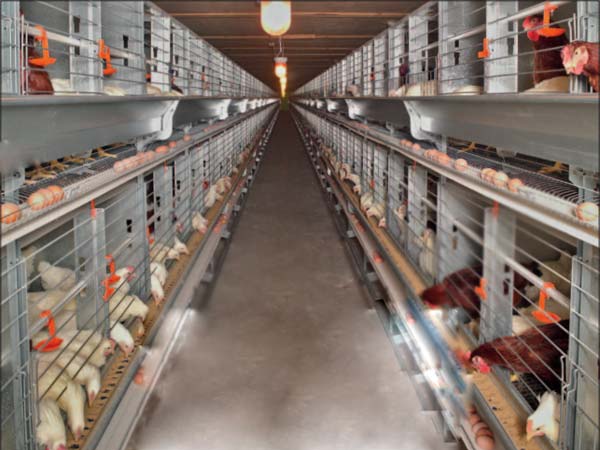Light is an important environmental factor affecting chickens. It is necessary to know that suitable light can stimulate the secretion of sex hormones in hens, enhance the activity of ovaries and fallopian tubes, accelerate the formation and discharge of eggs, and the development of fallopian tubes, thereby improving the production capacity of hens. We should pay attention to these techniques when using chicken poultry cage equipment to raise chickens.
Do not reduce the lighting time during the laying period. The first time of adding light is 18 to 19 weeks old, and the light is generally started by the standard weight of 18 weeks old. For example, the standard weight of 18 weeks of age is 1.55 kilograms, that is, the light stimulation is started with the weight of 1.55 kilograms, but no later than the end of 19 weeks. The addition period is determined according to the weight of the chicken group, and it is generally preferred once a week. The time for adding light shall not exceed 1 hour, and the period of addition shall not be more than twice a week, nor less than two weeks. According to the light cycle to determine the duration of the light, generally the first two light stimulation is better, if the light is applied once a week, it is recommended to add light for the first two times, and then increase by half an hour every week until 14~16 hours; If you add twice a week, split the one-week addition time into two. The peak lighting time must not be less than 15 hours. The upper limit of the illumination time is 16 hours, and constant illumination is applied when the upper limit is reached.
Be sure to consider the consumption and increase of the flock before adding light. The increase in illumination is mainly due to the fact that the chicken population does not meet the standard and needs to stimulate the flock to feed, thereby increasing the weight of the chicken population. Lighting management must take into account the effects of natural light length and seasonal factors to develop a reasonable lighting program. When supplementing the light, the power supply should be stable, and the floor area should be about 3 watts per square meter.

Brooding period. Both chicks and broiler chickens are in a growing period. At this stage, light management should promote the healthy growth of chicks and have a high survival rate, but prevent hens from reaching sexual maturity prematurely. Chicks can grow well under low light intensity, but in order to make them eat and drink as early as possible, the first week of light can reach 12 hours per day, and the light intensity can be larger.
Breeding period (7-20 weeks old). The main purpose of light management is to control growth and development, and to achieve sexual maturity at the appropriate age. Premature sexual maturity, not only the egg weight is small at the time of opening, but also due to insufficient maturity, it will be discontinued shortly after the start of production, and then it will not be stable and high yield. From the stage of young chicks to 10 weeks of age, the length of light duration does not have much effect on sexual maturity, while the age of 10-18 weeks is critical.period. The lighting time is short during this time. Chickens raised in closed houses are completely artificially illuminated, and the duration and intensity of light can be controlled.
Laying period. The principle of light management during laying period is to enable hens to start production and reach a peak at the right time, giving full play to their egg production potential. Therefore, the illumination time should be long, and it should not be gradually shortened, and the illumination intensity should not be weakened. During the laying period, it is generally used with increasing or constant illumination, but not less than 14 to 17 hours of light per day. Laying hens are very sensitive to light hours. Generally, they start from 21 weeks of age, and give chickens 13 to 14 hours a day. After that, they increase by 30 minutes per week and increase to 17 hours to maintain the peak of egg production.
After determining the addition period, do not change it at will. In the process of adding light, if there is a large difference between the actual body weight and the standard body weight, the lightening interval can be appropriately extended, but it must not be longer than two weeks at the latest. From the beginning of the light to the peak of the egg production, it is generally better to stimulate it continuously for more than eight times. The light intensity should not be arbitrarily changed during the addition of light, which has an effect on the growth and development of the chicken in the automatic poultry farming cage.
